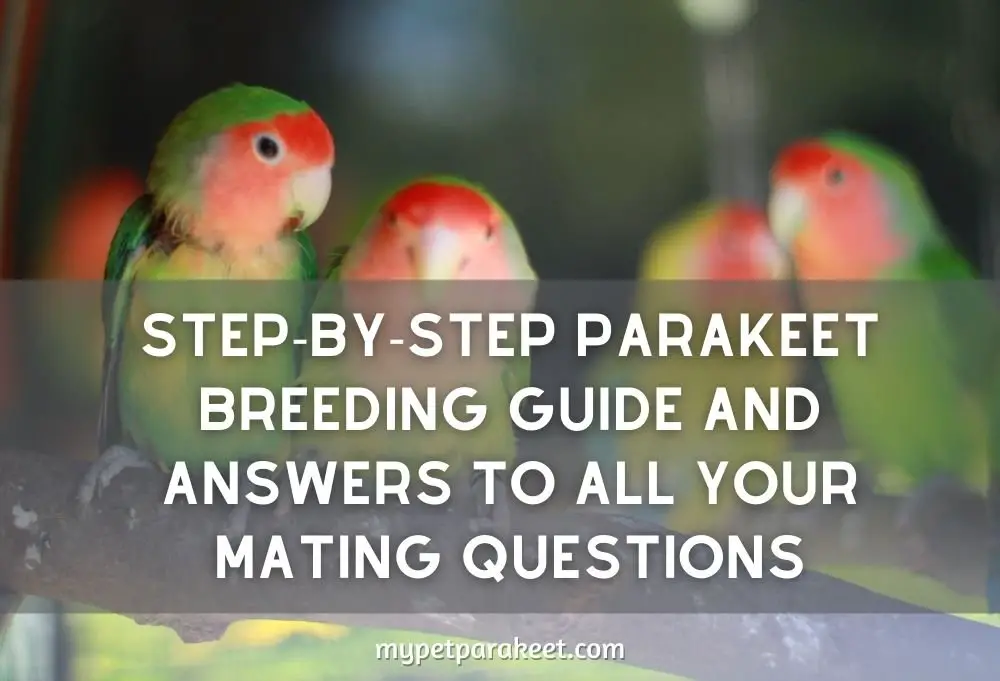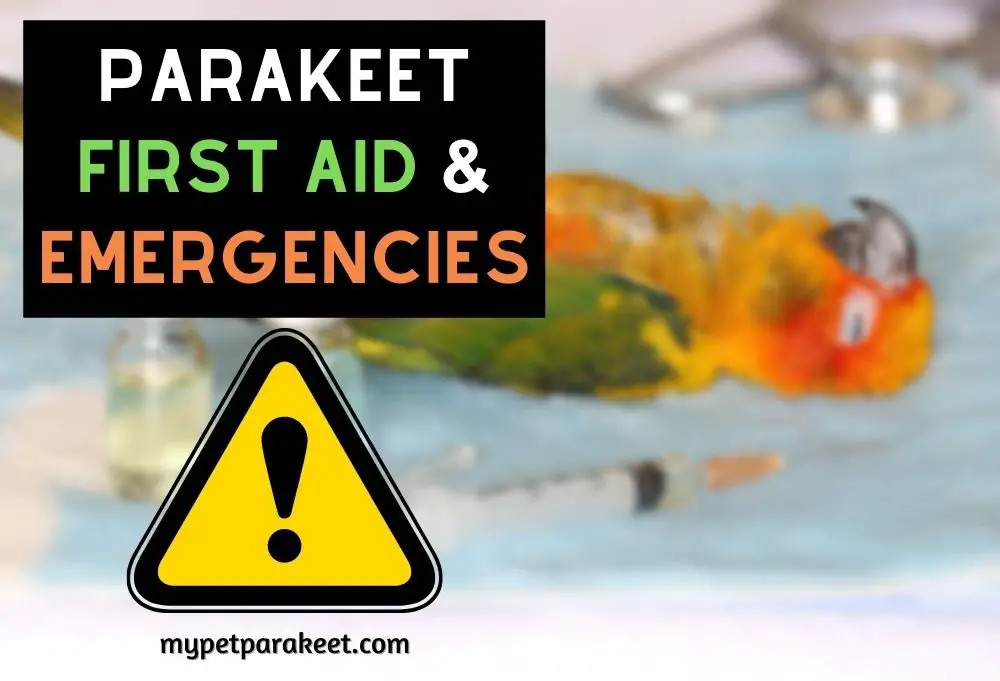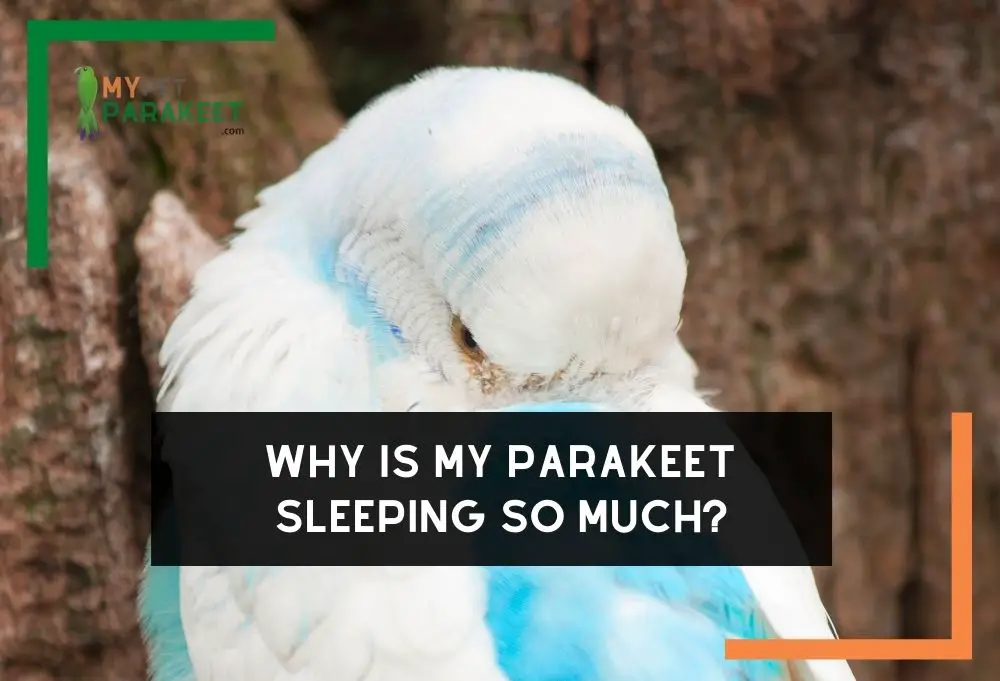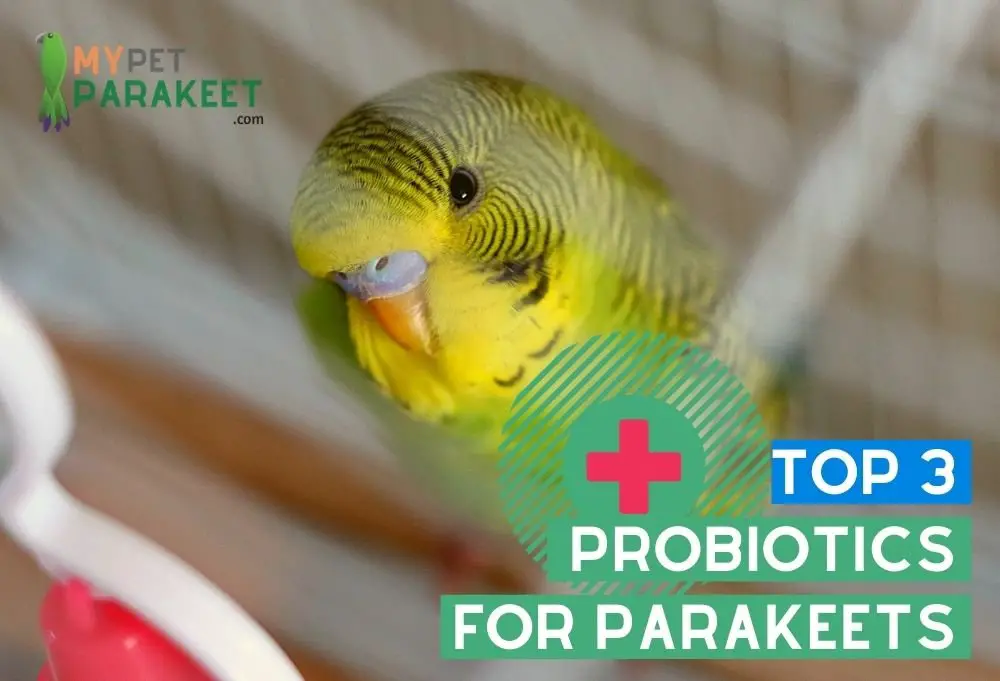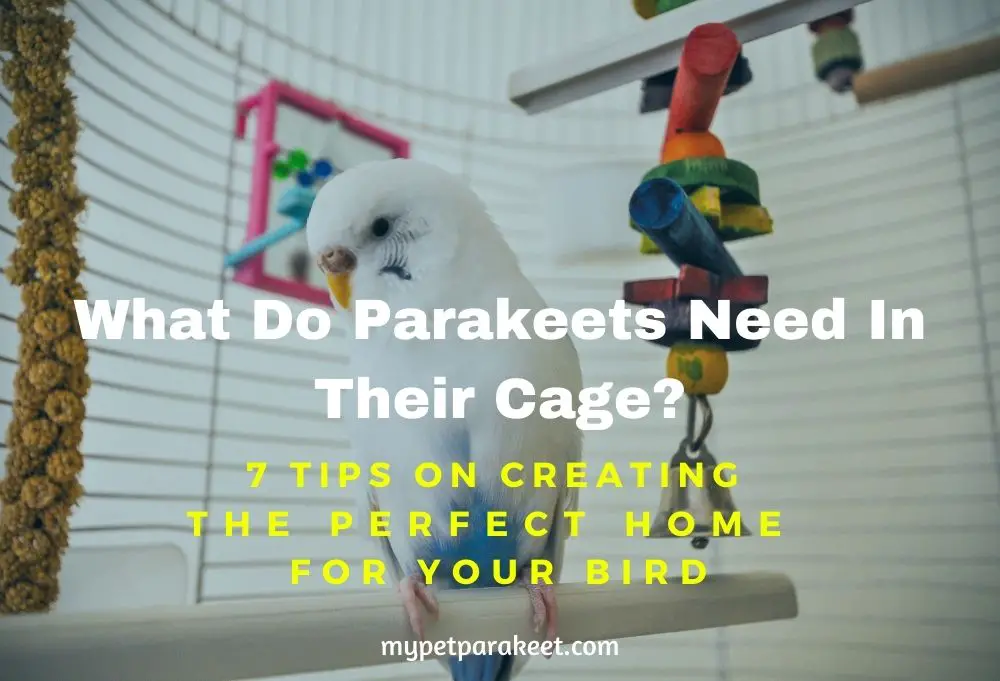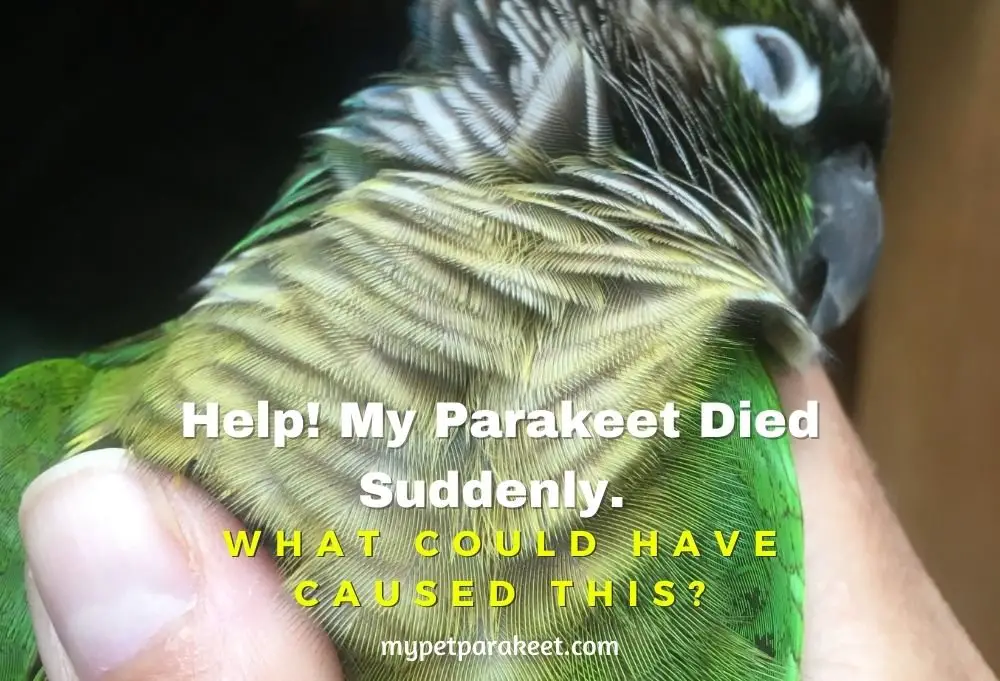Do you have a parakeet and are wondering how to breed them? Well, I'm here to tell you that it is easier than you think. All you need is a male and female bird, some nesting material such as shredded newspaper or straw, an incubator and the patience of a saint! This blog post will give you all the information about breeding parakeets and answer any questions that might come up along the way.
Mating can be tricky for new pet owners because they don't know what signs to watch out for in their birds. The first step is usually figuring out if your bird has reached sexual maturity by determining its gender and going from there.
This post goes into great depth and covers many common breeding questions, so use the Table of Contents box to jump to the topic you need.
- Pre-Breeding Questions
- Preparing For Breeding
- How to Breed Parakeets
- Parakeet Egg Care
- What Can Happen If You Don't Keep Up With The Eggs And Chicks?
- What To Do When Your Bird Lays An Egg Or Two But Doesn't Incubate It Properly?
- How Do You Know If Your Bird Is Laying Eggs?
- What Should I Do If My Parakeet Lays An Egg That Isn't Fertile?
- Why Can't My Bird Lay Eggs Anymore, Even Though She Was Just Fine Before?
- Can I Tell The Gender Of A Baby By The Color Of Its Eggshells?
- Do I Need An Incubator Or Can I Just Use An Egg Carton In The Fridge ?
- Should I Handle My Parakeet's Eggs?
- After Breeding, Should I Keep My Parakeets In Separate Cages Or Together?
- Will My Parakeet Start Eating Its Own Babies Once They Hatch?
- Newborn Parakeets
- Resources For Further Research On Breeding
- Conclusion
Pre-Breeding Questions
Deciding Why You Want To Breed Your Parakeets
Before you decide to put your pair of budgies together, carefully consider the pros and cons. If you want to make money, you may have to prepare for disappointment; otherwise, it is a wonderful experience that will grow stronger as time goes on.
The reason we say you may have to prepare for disappointment is that the pet stores buy their birds from a large network of breeders, wholesalers, and distributors who all closely control the cost to keep overhead low.
The pet bird industry is a booming one, and birds are bred for less than the cost of feeding their parents. You can't compete with them unless you have a wide variety in color that sells at only slightly higher prices than your average colored bird.
A business involving animals is subject to all types of legal requirements, from city and state permits to inspection by agricultural officials. If doing this correctly and all above board, you will have some ownership fees you'll need to pay for too!
In some areas, you will not be allowed to breed birds for sale at all. You must first check zoning ordinances before beginning this process if your area does allow it.
Or maybe you have planned to breed your pet parakeets as a hobby. Have you thought about what happens if you end up with five or six baby parakeets after breeding them?
Do you have the space and resources to take care of them all?
What Are The Benefits Of Breeding Parakeets?
Breeding parakeets is a great way to create unique and precious birds for the world. Some of these benefits include:
- Furthering parakeet research
- Breed rarity and color varieties that are not yet available through bird shops or pet stores
- Potentially finding many new varieties of parakeets over time
- The chance to be an avid breeder with your own breed creations
- To find solace in animal care during periods of stress or loss. Parrots are one of the few creatures which can provide lifelong, daily companionship and affection without human demands. They can do some impressive tricks on command and want nothing more than a light perch on your shoulder while you work around the house.
- Breeding encourages new mutations of different types, such as size or feather colors. It's a good idea to mix up some common colors among the pairs or take chances with something unusual.
- Another benefit is, if you have children, breeding parakeets is a great way to show children about the circle of life. It just requires some time, patience, and effort on your part. However, it doesn't take much investment on their behalf in order for them to learn all they need to know about breeding parakeets while bonding with you – giving them something extraordinarily valuable that money couldn't buy!
How Do You Know If Your Parakeets Are Ready To Mate?
Parakeets are ready to mate when they are sexually mature. Generally, different birds have different rates of maturity, so you should research the specific species and breeds before attempting to breed them.
When a female is considered ready, it will usually be obvious by observing her behavior and appearance. For instance, she might sit in males' territory all day waiting for mating opportunities, or she might constantly chase any male close by her.
If there is no readiness behavior from her, then mating should not happen because the male would only get frustrated and potentially injure both himself and the female if he tries anyway.
Once females appear ready, surrounding birds will also follow a much more aggressive attitude than usual over these females, which would lead to fighting amongst males who want to give their best.
Signs of maturity and breeding readiness:
1) Aggression
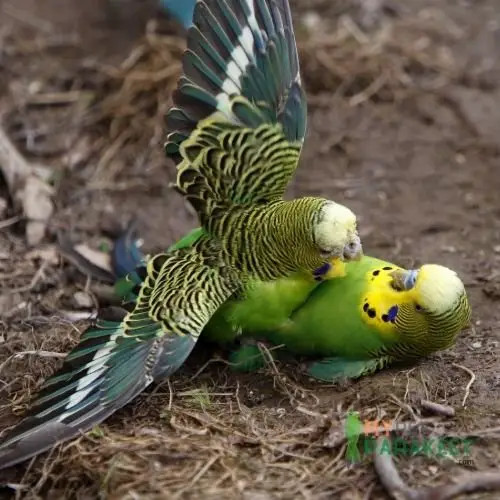
Aggression can take many different forms.
This includes biting people who own the bird, being protective of their cage, and being aggressive with food.
Aggression in birds is usually more common in males than females, but not always. Sometimes the female is more aggressive than the male.
2) Biting
Mature birds might bite their owners because it is how they protect themselves and the cage. The bird could also be jealous of other people paying attention to its owner or not like who's with them, so in turn, bites back at them. This biting can sometimes go as far as a mature bird being angry enough about another person for wanting to take away his mate that he'll attack!
Mature birds will also bite when they feel threatened. Sometimes you can tell that they are about to bite because their eyes get wide, and their tail starts fanning back and forth rapidly. If the owner does not stop what he or she is doing then there's a chance that the bird might end up biting them!
3) Display Behavior
If your bird starts doing things like strutting, singing, and waving his wings in late winter or early spring, he is probably trying to get a mate. If your bird has a crest on its head, it will raise the crest during this time also.
Are Your Parakeets Healthy Enough?
If you want to breed your parakeets, it's important to make sure they're healthy.
- First, check their beaks and nails carefully for signs of infection or injury.
- Additionally, healthy birds should show no signs of feather plucking, weight loss, or changes in posture.
- You also need to keep up with the vet appointments – because, in addition to being an indicator of overall health, active bird vaccinations are essential for preventing some diseases.
- And since you may need access later on for special tests, vaccines do not last forever, so there is a schedule where the booster shots are given every six months or twelve months as necessary.
- After everything is checked out and looking good, you can start the mating process!
How Do Parakeets Actually Mate?
This is probably the most puzzling part of the mating process for humans. But how do parakeets physically reproduce?
As male parakeets do not have “private parts”, many people wonder how they reproduce. The male parakeet's sperm is produced in reproductive organs located well inside the body and then expelled into female during copulation, which is termed cloacal kissing.
How Often Should My Parakeets Be Bred?
Parakeets should not be bred too often. Breeding frequency and high inbreeding can lead to reduced fertility, stillbirths, egg binding, or other defects.
When Is The Best Time To Breed Them?
There are no set “best” times for breeding parakeets but it is recommended that your female parakeet is at least 1-year-old but younger than 3-years-old for the healthiest hatchlings.
When you're ready, it's a good idea to sit your birds near one another in the same enclosure – they'll either mate or not and will tell you pretty much right away if that's what they want! It can take up to four weeks from mating until babies can be seen, so it might take a few tries before even one egg hatches successfully.
Generally, their egg-laying or breeding cycle can be decided by factors such as food availability, daylight hours, and weather.
So it really depends on the specific circumstance and what your goal is.
Preparing For Breeding
How To Prepare For Breeding Season
- In order to prepare for parakeet breeding season, it's important to provide the right environment so they can nest.
- You will need at least a 20-inch tall birdcage with plenty of perches and places for them to sleep on.
- It should be well lit but not too warm.
- Place your parakeets back in the cage at night if you want them to breed in the future, or release them outside overnight if you don't want them to breed.
- Make sure they have food dishes that won't spill, water bottles that stay full, and plants or branches for climbing.
- Make sure their cages are cleaned weekly!
Parakeet Mating Habits And Behaviors
Male Parakeets
Male parakeets display their behavioral interest by chasing female parakeets or by performing a “tail stand.”
Male parakeets perform courtship behavior to attract the attention of females by puffing up their chests and displaying bright feathers. They also use vocalizations for this purpose, such as an ‘alarm call.'
Similarly, a male parakeet will often perch near other males or flock members to show his dominance.
If he has made another male feel especially threatened though production of intruder calls in rapid succession while attacking him furiously from face to back with quick wingbeats, wing-rattling, or pecking at the other bird.
The one who dominates territory is awarded both the first pick of a nesting site and the attentions of females when they are fertile.
Female Parakeets
Female parakeets often select a male parakeet to mate with, but they are not obliged to do so. They will often show interest by performing courtship behavior and vocalizations.
Purchasing A Pair Of Parakeets To Breed
The best way to purchase parakeets is from a breeder. A reputable breeder will have the parents on the premises, usually in large flights or aviaries.
No matter what you do, always ask for references and shop around before making a purchase. Keep in mind that you may pay more upfront for quality.
What's important is to go somewhere that has been dependable over multiple generations of buyers and sellers.
Some questions to ask breeders or reputable pet store owners:
- – How long have you been breeding parakeets?
- – What is your parakeet's health guarantee?
- – Are the parents on-site and able to be seen by me?
- – What are the parakeets eating, how often do they get fresh water, where do they sleep at night, etc.
Make Sure Your Parakeets Are Not Related!
When you’re choosing two parakeets to mate, make sure they're from different family lines. Birds that are related will often breed with each other since one of them is usually male and the other female. This can lead to all sorts of problems in their babies like deformities or illness if any survive at all! If a parakeet's parents were bred by separate people though (like grandparent-grandchild), then there might be less risk for those types of birth defects happening when mating occurs between these birds as well.
How Much Food Does A Pregnant Female Parakeet Need To Eat Each Day ?
Each day, a pregnant parakeet will need about 1 tbsp of fresh fruit, such as grapes or apples.
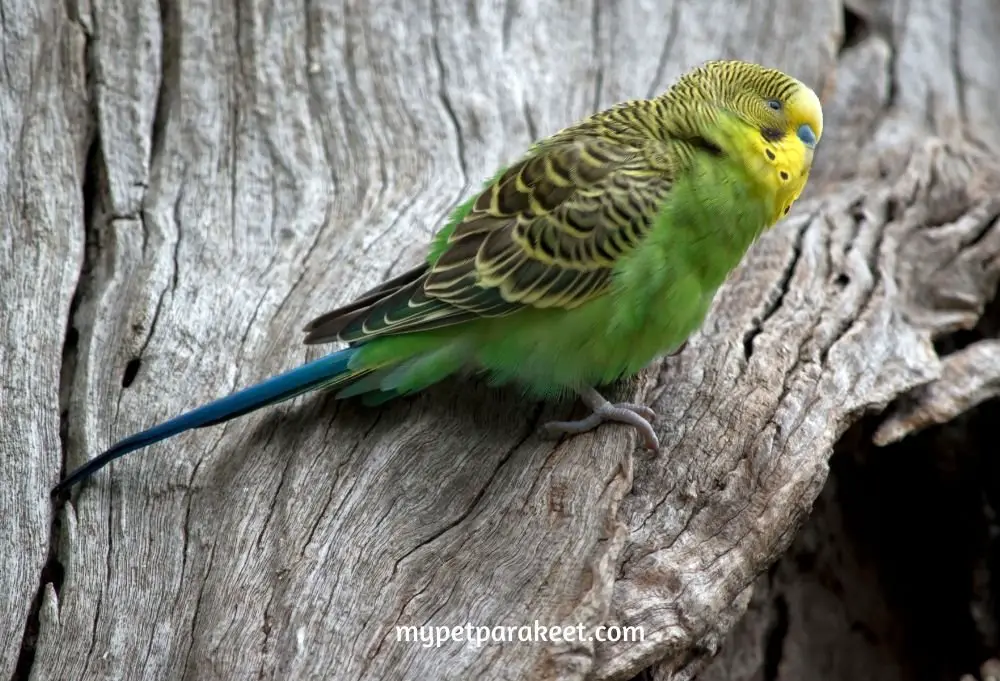
The female should also be given 1/2 tsp of nut butter and seeds each day.
The male should get 3-1/2 teaspoons of seed, peanut butter, or nuts each day.
If you live where it gets particularly cold in the wintertime, your birds will require additional dark leafy greens for vitamins A and E that are lost during the colder months.
Safflower (a fat source) is also a favorite of parakeets and can be given to your female parakeet.
How Do You Stop Them From Breeding/Mating?
If you do not want them to mate, it is best to keep the female separate from other birds, or you may end up with a seriously injured bird. Male parakeets typically become very aggressive when they want to mate!
How to Breed Parakeets
Now that you know all about the breeding process and common questions about parakeet health and mating have been answered. This is the information you need to start the breeding process. Following this, will be the cost breakdown of materials needed, such as cage, nest box etc.
Ensure Your Parakeets Have Properly Bonded
Two parakeets will bond and create a relationship if they are introduced properly and surrounded by the right environment. However, you could have two parakeets who get along well and appear to be bonding, only to find out that they are two males or two females.
So that you don't waste your time, it will help to know the differences between the genders. The good news is, they are easy to differentiate as they are sexually dimorphic, meaning there are subtle differences in plumage color, size, tail, etc that can help you determine the gender.
Males Parakeets
If the parakeet has a blue cere and completely blue nostrils then they are male. Some of these males have beautiful markings that make them look like little jewels!
Females Parakeets:
The cere on the female parakeet is a light blue color. You will notice there are brown rings around her nostrils, which you won't see in males; these signs of maturity indicate when she has reached sexual maturity.
The texture of her cere changes to rough as well over time and can be seen by looking at it closely for any irregularities like bumps or nicks that may have been more pronounced during youth.
How Well They Have Bonded Will Determine If They Breed Or Not
As mentioned above, properly introducing your parakeets is the key to them getting along, and the next step is their bonding as a result of getting along!
Ensuring they have enough space to play and perch as well as good quality food, consistently, will set a brilliant tong for happy, healthy parakeets to bond (and breed).
Once you have observed your parakeets sitting next to each other on the perch and even following one another around, then it is clear that there is a high level of intensity in their bonding. This becomes evident when males start feeding females; something which can only happen once mates are bonded.
The most intense bond between two birds happens through mating, with both partners feeding one another (usually male feeds female). That is when you will know they are in a healthy, monogamous relationship.
Your Parakeets Will Come Of Age (If They Are Not Already) And Be Ready To Breed
Parakeets are usually mature at just one year of age. To know for sure if your female is ready to start breeding, have a look at her cere; it should be brown and crusty-looking. Now all you need to do now is set up their nesting boxes so they can start nesting.
Your male parakeet will begin to chase the female around, making them very stressed and agitated. This is a natural process they go through in order to make sure the female parakeet wants to mate with him! They are not doing it out of spite or anger; rather, it's their way of showing interest.
If your parakeets are not nesting, make sure that they have a lot of sticks and plenty of different kinds to choose from so the female parakeet can decide which she likes best for their nest.
Breeding Cage Setup
The parakeets will need plenty of space to nest, so you should use a parakeet breeding cage. This is usually around 18 x 24 inches in size with perches on both levels (or more). You can also put some branches inside for them to be able to build their nest.
Cost Breakdown Of The Bird, Cage, And Accessories Needed To Start Breeding Them
1. Pair of birds (if you do not already own them)
The cost of a pair of parakeets can range between $20-$50 each depending on gender or species, but it's possible to find cheaper options by looking at pet stores or online classifieds as well as pages offering pets up for adoption.
2. Breeding Cage
Your breeding cage will likely be your biggest single expense. Breeding cages range from $30-$500, depending on brand and size.
We recommend that you purchase the largest cage possible (appropriate for your living space) to give parakeets room to fly around with a little extra space for nest-building material or food dishes.
You can also put perches in different areas of your breeder's cage if there is not enough available space for parakeets to perch.
The appropriate cage size for parakeets: up to you, but make sure it's enough space for them to fly around in without feeling cramped.
3. Food
You will need a variety of food such as seed mix, pellets, and vegetables for your breeding parakeets. Especially for the female parakeet as she is the one growing all the little eggs!
Note that the female parakeet needs more calcium than her mate to allow her body to grow eggs.
A seed mix and bird supplements can cost up to $150 a year, sometimes more, depending on the number of birds and diet. Similarly, whether you are buying non-GMO and are including treats such as millet spray will shift that amount.
4. Perches
Your breeders will need plenty of perches to rest on. The parakeet perches should be as wide as possible to prevent injuries from the parakeet's feet gripping too tightly and causing damage, which can lead to infections, among other things.
They will also need space to perch next to each other and mate! Perches cost around $20, depending on the size.
5. Cleaning supplies (to clean the cage)
Bird-safe cleaning supplies to keep the cage consistently clean are especially important for parakeets because they can be exposed to respiratory infections and other diseases.
This is an excellent bird-safe cage cleaning spray. But in general, you are looking at between $10-15 for a 16oz spray bottle.
6. Plantlife for the cage – live plants, fake plants, or both.
A parakeet's cage should have at least a couple of plants; live and fake are both fine but remember that you will need to replace the plastic one with fresh ones every few months as they deteriorate from use.
7. Nesting boxes
The nesting box is one of the most important purchases you will make in your breeding cage set-up, as parakeets mate in the nesting box.
The best type of nest boxes to use are those that have a hole on each side and can be dismantled for easy cleaning. A good size is about 12 “x12”.
Nesting boxes like this little wooden one come in various sizes and are available for under $20.
8.Nesting material
You will also need to purchase some nesting material such as shredded paper, softwood shavings etc. You can use any, as long as it is non-toxic.
Parakeet Egg Care
In this section, we will try to cover the most common questions new parakeet owners and hopeful breeders have surrounding parakeet egg care.
What Can Happen If You Don't Keep Up With The Eggs And Chicks?
Failure to keep up with the eggs and chicks will result in a decrease in the hatching rate.
Also, if you let your bird's supply of food run low, you're opening them up to a host of problems. Things like irregular heart rhythms, rapidly increasing levels of sugar in the blood (D-glucose), panic attacks, and sudden death directly relate to malnutrition.
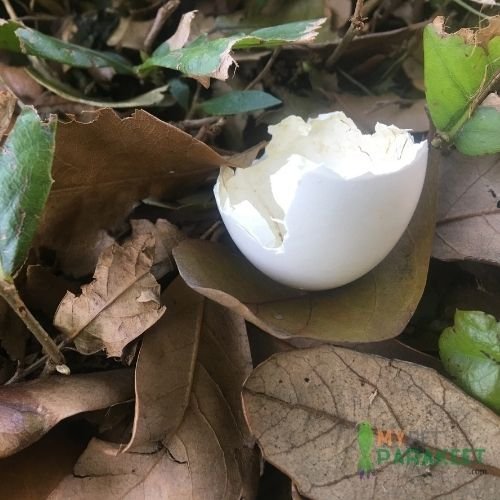
All these are vicious symptoms that can occur with no notice or warning because they stem from overworked kidneys and compromised brain function. They won't take much for this already frail bird to have its health crumble under the weight being borne by its organs.
What To Do When Your Bird Lays An Egg Or Two But Doesn't Incubate It Properly?
Although this kind of thing rarely occurs, it's not unheard of. When a bird lays an egg but fails to incubate it properly, or abandons the nest altogether, or can't seem to break out of the start-over cycle, it needs assistance right away.
This is because eggs are usually laid one by one each day, and there may be four or five days between eggs when you only see two. Eggs will not hatch if they are not incubated.
In most cases, however, leave them where they are in the nesting box unless you have an incubator to put them in to warm them.
How Do You Know If Your Bird Is Laying Eggs?
It's actually not easy to know if your parakeet is laying eggs. The most obvious clue would be an egg in their enclosure.
However, if you notice that your little parakeet is looking a little lumpy down below and feels a lot heftier than usual, it could be egg-laying season!
A less obvious way of telling is by visual inspection of the cloacal region to see if there appears to be an opening that would indicate she's ovipositing.
What Should I Do If My Parakeet Lays An Egg That Isn't Fertile?
You will need to tell the difference between an infertile egg and one that is fertile. If you are unsure or want confirmation, consult a vet or avian specialist.
There are many reasons parakeets may lay infertile eggs, including but not limited to old age, injury in adolescence, or adulthood that has impacted the production of hormones necessary for fertilization. A veterinarian should be consulted before issuing treatment if there is any uncertainty as to the cause of the infertility.
If it's determined that your parakeet has been producing empty eggs for some time without getting pregnant anywhere along the line, then it's likely she's just not currently capable of having babies.
Why Can't My Bird Lay Eggs Anymore, Even Though She Was Just Fine Before?
A common cause of egg-laying issues in pet birds is the condition called egg binding. Egg binding occurs when your bird can't pass an egg down her oviduct, and this obstruction prevents her from ovulating. The pain caused by a stuck egg will usually lead to severe feather plucking or self-mutilation from the hen as she tries to gain relief.
To diagnose an impending case of egg binding, look for objects near the vent which resemble eggs but are hard or deformed. They will be different shapes and may contain something yellowish or greenish on them (the contents of the inside of the area that was being blocked), and you may also see foam on their feathers around their vents if they've been trying to pass the egg for some time.
If you suspect your parakeet is about to develop a case of egg binding, contact an avian veterinarian immediately or start administering calcium supplements orally in order to prevent further damage. You may also need antibiotics if there are signs that infection has set in, and it will take days before symptoms show themselves.
Can I Tell The Gender Of A Baby By The Color Of Its Eggshells?
Unfortunately, no.
It's a common myth that the color of a bird eggshell can predict what gender is inside – unfortunately it's not true for either humans or birds! It may be possible to determine the evolutionary sex of some animals by looking at their DNA in embryonic tissue inside the egg, but this isn't true for humans, and it doesn't work as well for birds either.
Do I Need An Incubator Or Can I Just Use An Egg Carton In The Fridge ?
You'll need to be using an incubator. All embryos kept at a temperature below 100° F (37.8° C) are considered under-incubated. The chick will likely never hatch, or if it does will most likely develop improperly or be stillborn. If you want to hatch chicks from your eggs, you can buy an electric incubator and follow the instructions that came with it for best results.
Should I Handle My Parakeet's Eggs?
You shouldn't handle your parakeet's eggs.
Handling the eggs may end up weakening the membrane and the egg will break, leading to death for many, if not all of them. The only exception to this is if you are incubating the eggs and need to turn them.
If you're not incubating the eggs, don't handle them at all.
After Breeding, Should I Keep My Parakeets In Separate Cages Or Together?
The easy answer is to keep them together because if they have bonded as it will give them greater mental stimulation.
However, there are a few considerations for keeping parakeets that I want you to consider.
- If your aviary is large enough with plenty of perches, food dishes, water bowls, and seed cups, then you can keep the parakeets together in one aviary or cage.
- If their cage is small or cramped, you may want to separate them or buy a larger cage.
- If you have parakeets that seem to be fighting, then it is best to separate them.
That being said, parakeets are very social animals, and they do better parakeets are very social animals, and they do better when they are together. That means you should have at least two, but the more, the better. They are highly intelligent creatures that need constant stimulation and interaction, not just with other birds, but humans too.
Will My Parakeet Start Eating Its Own Babies Once They Hatch?
Nope.
First of all, your parakeet will not be harming her chicks by eating them after they hatch. Secondly, you also need to make sure that everything is going well with momma in terms of getting enough food and water and making sure she never gets too stressed out. Some birds might start pecking at their babies when they're having trouble finding food or are too nervous- but if conditions are favorable for momma, then there shouldn't be a problem with your beloved pet eating its eggs.
The most important thing to watch out for is momma trying to eat her eggs prematurely– this means either that she really is hungry and needs to eat, or that she's too stressed out. Parakeets are typically pretty good parents and will only start eating their eggs if they're in dire need of food or severely lacking nutrients.
Momma parakeet is a little more dependent on human intervention than most birds, so make sure you have enough time to watch her carefully for the next few weeks.
Newborn Parakeets
In this section, we will try to cover the most common questions new parakeet owners and hopeful breeders have surrounding newborn parakeet care.
Tips On Raising newborn parakeets
Some tips for taking care of your baby parakeets.
Parakeets are just as fragile and delicate when they're babies. You'll need to keep the nest low in their cage, use clean, fresh material for them to lay on (no chemicals or dyes), place some soft cloths round its nesting box so it can fall without any harm done, but be careful with these little ones because they're still very sensitive!
If you find that you need to take care of your baby parakeets yourself, you will need to know the most important aspect of baby parakeet care: feeding.
What To Feed Baby Parakeets
What do you feed newborn parakeets? Your baby parakeets need to be fed baby bird formula.
Hand-feeding Newborn Parakeets
Baby parakeets can be hand-fed until they're old enough for seeds and water on their own. Hand-rearing your newborn parakeets is only necessary if momma parakeet is not feeding them or if you have a large litter.
How Often Should You Feed Newborn Parakeets?
Between ages two to three weeks, your baby parakeets should be hand-fed every 3 hours.
After a parakeet is three weeks old, it should be fed every four hours.
And by six weeks, you can start reducing the intervals between feedings to five hours per day.
The frequency of feeding parakeets will depend on their age and how quickly they grow, so make sure to follow these guidelines.
How Much Formula Should You Feed Newborn Parakeets?
At age two weeks, your baby parakeet should be fed between 2 to 3 ml of formula at each feed.
Then, at week three, you should up that to 3 to 5 ml of formula
How To Know When Newborn Parakeets Are Ready To Eat On Their Own?
Parakeets can start to consume food when they are about four weeks old. This is more or less dependent on an individual's condition. For example, if a parakeet has adjusted well to its new environment and has consumed a lot of formula milk, it may be ready for regular food sooner than what is mentioned above.
Feeding times will vary over the first few weeks, but once they build up their strength and have begun to grow their feathers in their feeding time should get better and more consistent. When feeding starts, it will usually only last 5-10 minutes as they need that short break due to such small stomachs.
Resources For Further Research On Breeding
We wanted to share this great video on parakeet breeding. If you found it useful, be sure to give the creator a like and a comment!
Conclusion
Breeding parakeets is an exciting and rewarding experience that can bring joy to your life, but it's important not to jump in too soon. The tips we've shared will help you know when they're ready for breeding, how often they should be bred, what their mating habits are like with each other, and more! If you have any questions or need some additional advice on the topic of parakeet breeding, please feel free to leave us a comment.

